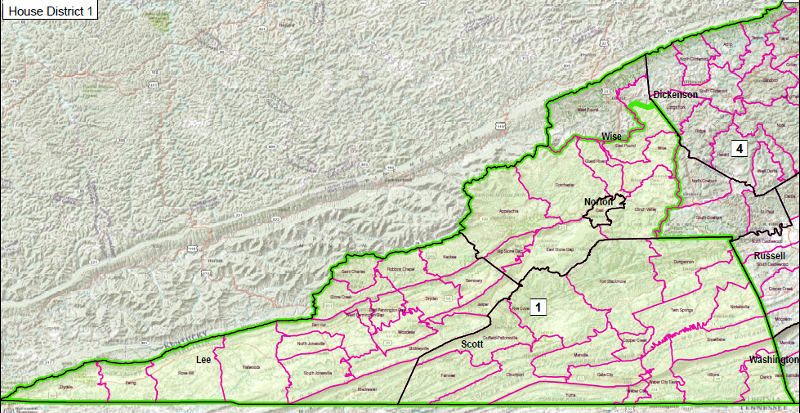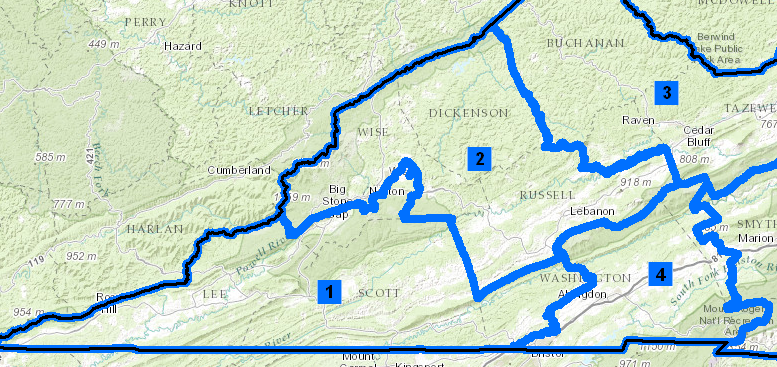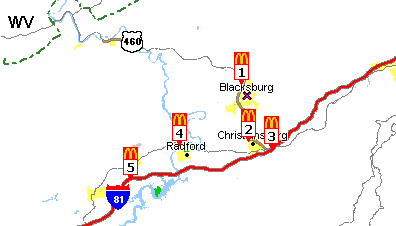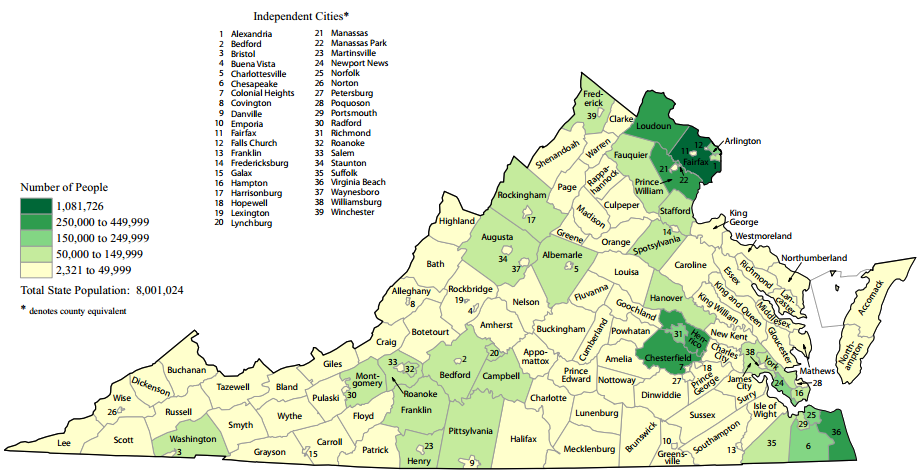
after the 2011 redistricting, District 1 of the House of Delegates included the entire southwestern tip of Virginia
Source: General Assembly Division of Legislative Services, Current District Maps - District 1
The US Constitution requires a census every 10 years, in order to rebalance how many members each state will elect to the US House of Representatives. That is the primary reason for a population count every decade.
Since the US Supreme Court ruled in 1964 that "one person, one vote" applied to state legislatures, every 10 years Virginia has redrawn the boundaries for its 140 General Assembly districts - 40 districts for the State Senate, and 100 districts for the House of Delegates.

after the 2011 redistricting, District 1 of the House of Delegates included the entire southwestern tip of Virginia
Source: General Assembly Division of Legislative Services, Current District Maps - District 1

from 2001-2011, District 1 of the House of Delegates included less territory - but faster population growth in other areas of Virginia required a boundary adjustment after the 2011 Census
Source: General Assembly Division of Legislative Services, Redistricting Plans
But why does the Census Bureau have additional surveys and ask more questions beyond "how many living people are located in this place?"
Various government programs are based on income levels, race, educational attainment (years of high school/college completed), etc. If a government program is designed to provide funding to replace outdoor privies with indoor plumbing, or to provide a hot lunch to school children from families earning below a certain amount of income... it helps to have data.
Today we can categorize the 8 million or so Virginians in different ways - by gender, by ancestry, by income, by residence, etc. Discrimination based on race is prohibited by Federal law, but selective marketing based on clear business criteria rather than racial prejudice is common.
Defining a "target audience" is essential for a business trying to match their product with their customers. Until recently, businesses used to blanket a community with advertising, even if that requires wasting money on some households, in order to be sure they reached all potential customers.
Advertisers placed commercials on all channels at the same time. Telemarketers used to call every phone number. In the early days of the Internet, America Online (AOL) used to send a disk to every household - even those without a computer - just to ensure every potential subscriber got the marketing materials.
Today, those telemarking phone calls, "junk mail" invitations for credit cards, and get-out-the-vote solicitations just before an election are based on sophisticated slicing and dicing of demographic data. After all, the Republicans don't want to encourage the Democrats to vote, or vice-versa. Companies trying to sell diapers want their advertising to be directed to neighborhoods with lots of young couple, not to retirement homes. As social media replaces direct mail, the refinements in identifying customer interests offer advertisers even more opportunities to discriminate - legally.
Knowing the audience of potential customers can make the difference between a successful business and a bankrupt business. Northern Virginia, Richmond, and Hampton Roads are the three areas of Virginia with high population density, high population totals, and a higher-than-average level of discretionary income in households.
If you are trying to sell expensive jewelry, would you locate your store near Tysons Corner or near Cumberland Gap? Census data helps business owners make that decision.
Remember the Hummer? Hummer dealerships were not located at random across the state. They were concentrated near wealth, because Hummers were luxury items. In October 2007, before the brand was closed down, there were only 4 Hummer dealerships in Virginia. Two were in Northern Virginia (Vienna and Chantilly), one in Richmond, and one in Virginia Beach. When Tesla opened its first car dealerships, it targeted Tysons and wealthy Henrico County just west of Richmond first, followed by Arlington, Norfolk, and Charlottesville.1
Fast food restaurants are located at highway intersections and in urban areas for a reason - that's where the customers are concentrated. There are exceptions to every rule, of course. A few restaurants in out-of-the-way locations may become popular, such as the Inn at Little Washington (in Rappahannock County) and the restaurant at the Chateau Morrisette winery (in Floyd County). Those restaurants have become intentional destinations for the traveler, and the inconvenient location is outweighed by the quality of the food and dining experience.

Drive south of Blacksburg, and you could eat at McDonalds - but go west to the West Virginia border, and it was a "food desert" for McDonalds aficianodos in Newport, Pembroke, Pearisburg, Rich Creek, and Glen Lyn (by 2011, a McDonalds finally opened in Pearisburg)
Source: McDonalds Restaurant Locator
The 2010 Census located 8 million people in Virginia (the "mean center" is in southeastern Louisa County). At that time, the United States had nearly 310 million people and the world population was approaching 7 billion.

Population of Virginia, 2010
Source: Bureau of Census, Virginia - 2010 Census Results (Total Population by County)